Results 1 to 2 of 2
Thread Information
Users Browsing this Thread
There are currently 1 users browsing this thread. (0 members and 1 guests)
-
12-09-2013, 09:53 PM #1Senior Member

- Join Date
- May 2006
- Location
- Nebraska
- Posts
- 2,892
Immigration Reform Power Tweeters: Part 1 and 2
James Witt Director of Center for Social Science Research, George Mason University
Immigration Reform Power Tweeters: Part 1
Posted: 11/05/2013 9:33 am
Follow

Conservatives, Immigration, Tea Party, Twitter, Immigration Reform, Liberals, Media, Progressives, Tweets, Politics News
31
2,266
2
0
Get Politics Newsletters: Subscribe
Beginning in February 2013, researchers at the Institute for Immigration Research (IIR) at George Mason University began tracking the national immigration reform conversation on Twitter. Our view: Twitter would be one of several social media venues where the evolving immigration reform debate could be tracked and analyzed. Since then, using DiscoverText and NodeXL, two different data mining applications, we've collected nearly 3 million tweets containing the word "immigration."
With a lot of data at our fingertips, we sought to identify who were the most influential tweeters about immigration reform, and how they interacted with one another. To do this, we identified the most influential daily tweeters about immigration between March and May 2013, as assessed by betweenness centrality -- one of several important statistical measurements of influence within a social network. We then looked at their connections with one another as of June 2013, using a Clauset-Newman-Moore algorithm -- a complex formula that sorts similar actors in a network into groups.
Below we reveal and describe five clusters of immigration reform "power tweeters." In a related post, "Immigration Reform Power Tweeters: Part 2," we delve further into the data to note some of the major similarities and differences between these clusters.
Cluster 1: The Mainstream
The first cluster, pictured in the image below, is dominated by mainstream news organizations. Also included in this group are significant numbers of celebrities and influential online commentators. John McCain, a well-known, pro-reform Republican, is the only politician included.
The primary shared attribute for members of this group is their influence in a broad range of topics. Not all of them tweet very frequently about immigration reform -- but when they do, their tweets are particularly influential, because these tweeters have many Twitter followers, and therefore have high visibility. Because of this, they are influential no matter what they tweet about.
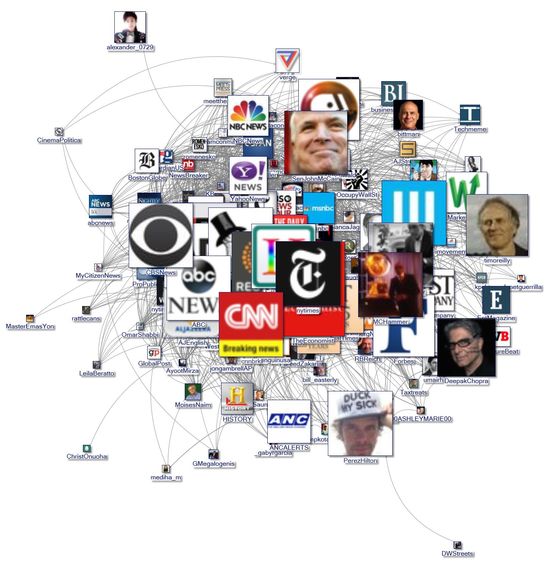 To better understand the composition of this group, we created a word cloud based on the words these tweeters use in their Twitter profiles. Most describe themselves as "news" sources on a wide variety of topics. Note that the word "immigration" does not stand out in these tweeters' profiles.
To better understand the composition of this group, we created a word cloud based on the words these tweeters use in their Twitter profiles. Most describe themselves as "news" sources on a wide variety of topics. Note that the word "immigration" does not stand out in these tweeters' profiles.
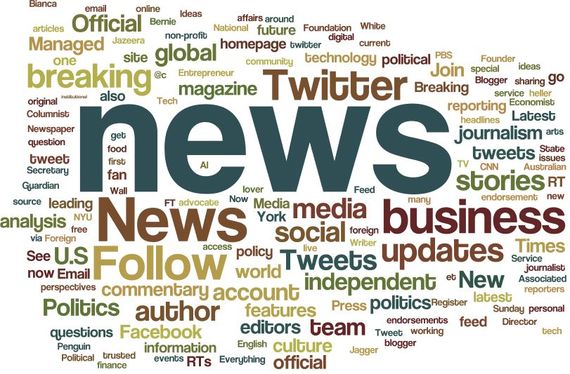 Cluster 2: The Reformers
Cluster 2: The Reformers
The second group is dominated by pro-reform individuals and organizations. These include organizations that embrace a variety of other progressive causes, such as the Human Rights Watch, as well as several that specialize in immigration only. Although they tend to have fewer followers overall (as indicated by the smaller images in the figure below), they are influential tweeters about immigration because of their greater focus on that issue. Extremely popular figures, such as President Obama, are the exception in this group.
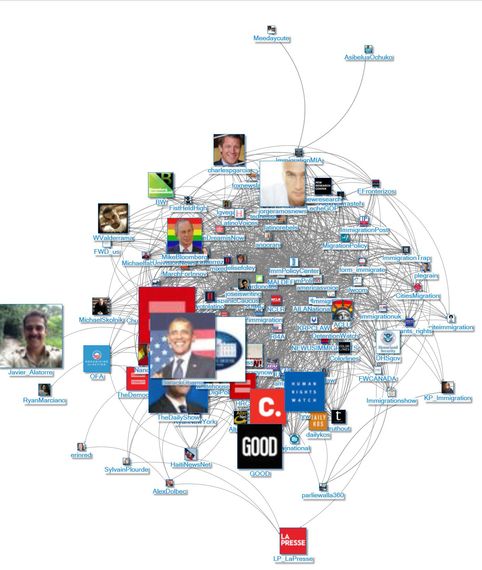 The word cloud based on these tweeters' profiles makes clear that many of them are especially concerned with immigration issues.
The word cloud based on these tweeters' profiles makes clear that many of them are especially concerned with immigration issues.
 Cluster 3: Progressive Media
Cluster 3: Progressive Media
The third group was the smallest of the five clusters. It consists of left-leaning news organizations, like NPR and Mother Jones; left-leaning bloggers and online journalists, like Markos Moulitsas, Josh Marshall, and Matty Iglesias; and left-leaning mainstream media commentators, like George Stephanopoulos, Joe Trippi, and Donna Brazile.
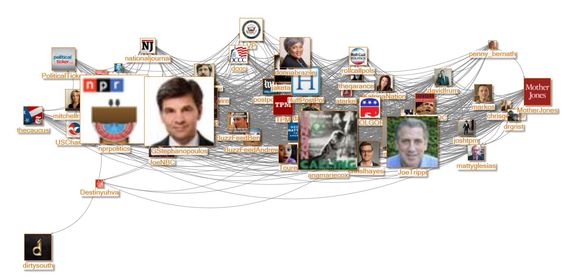 These tweeters tend not to explicitly highlight their political orientation in their Twitter profiles. Most identify themselves as political commentators, but most do not associate their commentary with a particular political agenda.
These tweeters tend not to explicitly highlight their political orientation in their Twitter profiles. Most identify themselves as political commentators, but most do not associate their commentary with a particular political agenda.
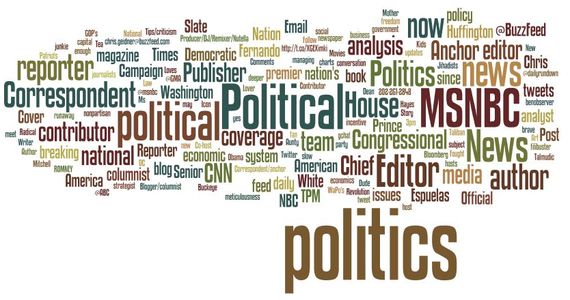 Cluster 4: The Institutional Conservatives
Cluster 4: The Institutional Conservatives
This group is a "who's who" of influential conservatives in the media and in Congress: Donald Trump, Marco Rubio, Michelle Malkin, Mike Huckabee, and Tom Coburn are just some of the individuals central to this network. Influential organizations, including Fox News, the Drudge Report, and the Heritage Foundation are also prominent members of this group.
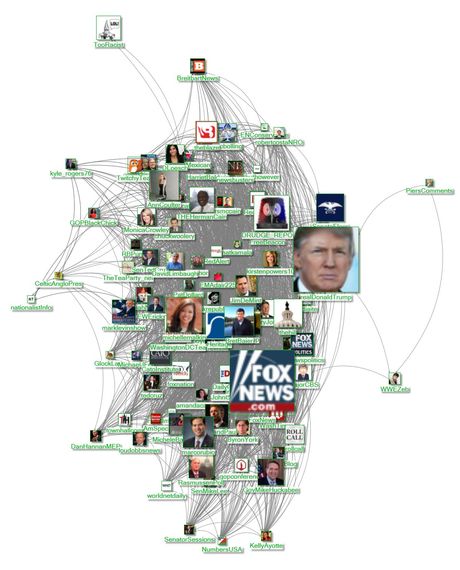 Unlike the left-leaning media, the members of this group tend not to be shy about making their conservative political views explicit in their Twitter profiles.
Unlike the left-leaning media, the members of this group tend not to be shy about making their conservative political views explicit in their Twitter profiles.
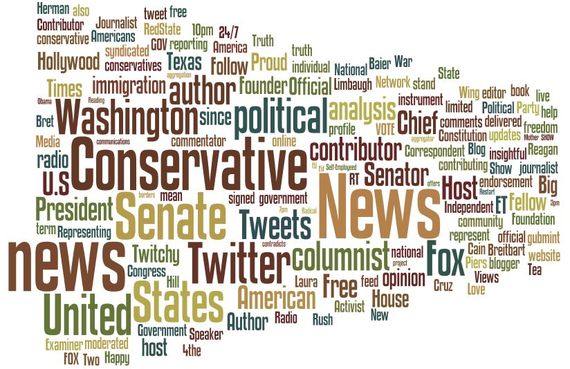 Cluster 5: The Tea Party
Cluster 5: The Tea Party
The final cluster we found in our analysis of immigration related tweets consists of conservatives who also identify or sympathize with the Tea Party. Unlike the other clusters, this one consists almost entirely of individuals. Furthermore, the individuals aren't affiliated with any prominent organizations: they are "ordinary" Americans. Cluster 2, the pro-reform group, has a significant minority of tweeters who fit this description--but Cluster 5 is dominated by them.
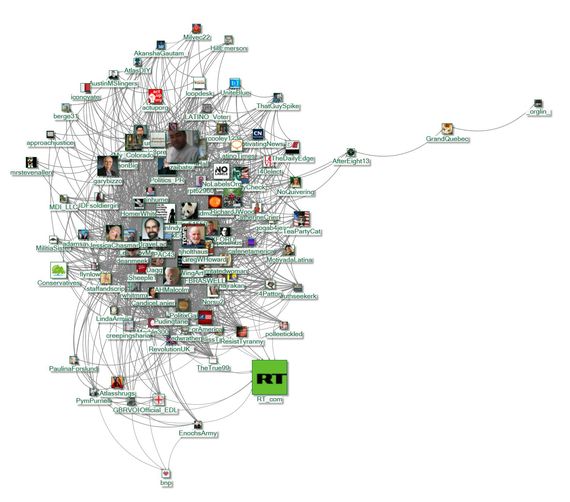 Moreover, the word cloud for this group reveals its members are even more adamant about touting their conservative viewpoint in their Twitter profiles.
Moreover, the word cloud for this group reveals its members are even more adamant about touting their conservative viewpoint in their Twitter profiles.
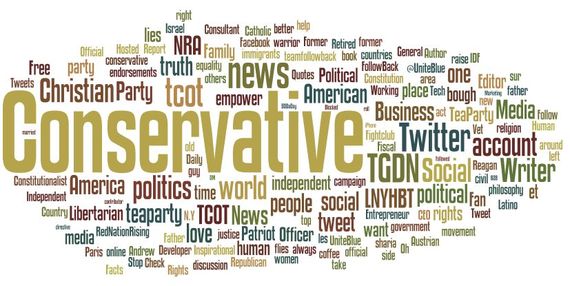 Conclusions: Power Tweeters and the Immigration Reform Conversation
Conclusions: Power Tweeters and the Immigration Reform Conversation
What can we learn from these clusters? Not surprisingly, we see that political affiliation is a major feature that distinguishes clusters of power tweeters from one another. There are two progressive groups, two conservative groups, and a mainstream group that, depending upon whom you ask, represents a mix of viewpoints or is biased one way or the other.
The second major feature appears to be the presence or absence of institutional affiliations. The reformer group is the most diverse in this regard, with a mix of Democratic politicians, progressive political organizations, and unaffiliated individuals passionate about immigration reform. Three of the other four groups, however, are dominated by institutions, or individuals connected to these institutions (e.g., journalists and politicians). By contrast, the Tea Party power tweeters are distinctive in that they are almost all individuals unaffiliated with any particular institution.
Does this mean that Twitter is primarily a social media platform dominated by elites, or that the Tea Party has harnessed Twitter in a way that other groups of individuals have not? Not necessarily. This particular data just looks at differences among the most influential immigration tweeters. It doesn't address the many thousands of other immigration tweeters, how these tweeting masses interact with the most influential tweeters, or how they interact with each other.
But other questions remain. Have each of these clusters attained their influence on Twitter in the same way? Do one or more of these clusters have more influence on the conversation than the others? And what about the connections between these clusters--are they all following and interacting with one another, or do they largely exist in their own little bubbles? We explore the answers to these questions in Part 2.
Co-authored with Randy Lynn
Randy Lynn is a Ph.D. candidate in sociology and a graduate fellow at the Institute for Immigration Research at George Mason University.
Follow James Witte on Twitter: www.twitter.com/@jameswitte
http://www.huffingtonpost.com/james-...b_4204157.html
-
12-09-2013, 09:54 PM #2Senior Member

- Join Date
- May 2006
- Location
- Nebraska
- Posts
- 2,892
Immigration Reform Power Tweeters: Part 2
[COLOR=#696969 !important]Posted: 12/09/2013 12:30 pm[/COLOR]
Follow

Conservatives, Immigration, Tea Party, Twitter, Immigration Reform, Liberals, Media,Progressives, Tweets, Technology News
12
61
2
1
GET TECHNOLOGY NEWSLETTERS:SUBSCRIBE
Beginning in February 2013, researchers at the Institute for Immigration Research (IIR) at George Mason University began tracking the national immigration reform conversation on Twitter. In Part 1, we revealed that our analysis had uncovered five clusters of power tweeters (see Figure 1): (1) Mainstream, (2) Reformers, (3) Progressive Media, (4) Institutional Conservatives, and (5) the Tea Party. In this article, we'll delve further into our data to look at the similarities and differences between these groups, and present several additional findings.
Figure 1: Clusters of Immigration Reform Power Tweeters
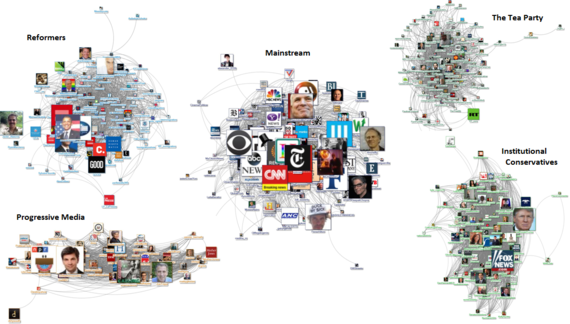
To begin, we examine two broad measures of influence to see if any of these clusters is more or less influential than the others. We then look more deeply at the characteristics of the tweeters in each cluster -- beginning with the length of time on Twitter, the number of tweets, and the number of followers and others followed -- to better understand the nature of their influence. Finally, we examine the relationships between the power tweeters in each cluster, to look at how relationships among themselves contribute to each group's overall role in the immigration reform conversation.
The basis for this analysis is found in the statistics reported in Figure 2. For each statistic, asterisks are used to indicate when the value for a cluster is statistically different from the value for the Tea Party cluster.
As an overall measure of influence, we can compare the average Klout scores for the power tweeters making up each cluster. A Twitter user's Klout score is a number ranging from 1 to 100 and is widely accepted as an indicator of an individual's online influence.
As Figure 2 indicates, the average Klout score for Tea Party members is lower than those for each of the other clusters. In all but one case (the Reformers), this difference is statistically significant.
Klout scores are representative of a tweeter's overall influence, but the measures found in the next two rows in Figure 2 -- betweenness centrality and impact -- are based specifically on our analysis of tweets containing the word "immigration."
- Betweenness centrality captures the load and importance of an individual tweeter. It indicates how well-positioned the tweeter is in the overall immigration conversation. While there are relatively large differences between the clusters (e.g., 731 for the Mainstream compared to 516 for the Tea Party) these differences are not statistically significant, because there are also large differences within each cluster.
- Impact is based on betweenness centrality, and refers to the average ranking (first through tenth) of members of each cluster when a member is among the top ten tweeters in term of betweenness centrality in a given Twitter snapshot. As described in Part 1, we used the top ten tweeters by betweenness centrality over several hundred snapshots in a four month period to generate our group of "power tweeters."
With our measure of impact, a low value indicates greater influence. As you can see in Figure 2, the impact score for members of the Mainstream group was on average about 25 percent more influential than power tweeters in other groups, including the Tea Party.
Figure 2: Measures of Influence for Five Clusters of Immigration Tweeters
To better examine the relative influence of these clusters, Figure 3 provides additional indicators of the Twitter presence of the members in each cluster. First, with the number of days on Twitter, we see that on average influential members of the Tea Party cluster are newer to Twitter than members of the other four clusters. Then, in the following row, we note that the number of tweets from the Tea Party cluster members is roughly similar to those from the other clusters-with the exception of the Reformers, who tweet significantly less often than all other clusters.
We found important differences between the Tea Party cluster and other clusters, however, in the next two rows of Figure 3, which provide the average numbers of Twitter followers and users followed by the members of each cluster. Here, too, we see an important difference in how these groups seek to become influential.
The Mainstream, Reformer, Progressive Media, and Institutional Conservative clusters all amassed huge numbers of followers, but didn't do much following of others by comparison. The average number of followers among these four groups ranged from approximately 165,000 to 867,000, while the average number of follows ranged from approximately 5,000 to 13,000.
By contrast, the Tea Party power tweeters had an average following of 47,000, far fewer than any of the other groups--but they averaged nearly 35,000 follows themselves, a figure three to seven times greater than the other groups.
One reason for this difference is a movement among conservative tweeters referred to as #tgdn, or the Twitter Gulag Defense Network, in which, according to the founder Todd Kincannon, "conservatives find and follow each other in order to defend against spam blocking liberals who get conservative Twitter users suspended." This strategy builds on the premise that Twitter is less likely to suspend a user with several thousand followers.
Figure 3: Measures of Influence for Five Clusters of Immigration Tweeters
This suggests that the influence of the Tea Party group is largely attributable to activity within its own cluster. Support for this interpretation may be seen in Figure 4. The clustering coefficient indicates that the members of the Tea Party cluster are significantly more closely tied to one another. In other words, this cluster is "denser" than all other clusters of influential immigration tweeters.
In addition, the reciprocity ratio found in the final row reveals that members of the Tea Party cluster are significantly more likely to both follow and be followed by one another than members of all other clusters.
Figure 4: Measures of Influence for Five Clusters of Immigration Tweeters
Conclusions
Based on the findings presented here, when it comes to the immigration reform discussion, one may be tempted to treat the cluster of influential Tea Party tweeters as a tempest in a teapot. Though tweeting at a pace comparable to members of other clusters, they do not have much influence on the overall Twitter conversation on immigration. But we believe that dismissing this apparent internal soliloquy as wholly unimportant would be premature.
First, the tweets we have analyzed here only cover one slice of time, between February and June of 2013. These tweets were made as the Senate was successfully passing a comprehensive immigration reform bill, prior to Speaker of the House John Boehner's July 2013 statement that he would refuse to put the Senate bill up for a floor vote by House members unless a majority of Republicans would support it. In short, it was a time when the Reformers and Progressive Media were on the "offense" with regards to immigration reform, while a significant number of conservatives were on "defense."
Second, this analysis just looks at power tweeters, not the whole of the discussion about immigration reform on Twitter. It is possible that the cumulative impact of many individuals expressing the same views as the Tea Party power tweeters could actually have more impact than that of the subset of most influential tweeters in the Tea Party cluster. This would require a different type of analysis to assess.
Finally, and perhaps most importantly, unlike Vegas, what happens on Twitter does not necessarily stay on Twitter. Tweeters with a Tea Party orientation are likely to have an impact on the immigration reform discussion quite apart from the conversation on Twitter. Being active on Twitter does not preclude offline forms of activism and influence. In fact, having a significant social media presence is increasingly a means to claim credibility in offline arenas. Our analysis of influential Twitter networks does not capture this sort of influence.
It remains to be seen how the interplay of online and offline dynamics might affect the ultimate outcome of immigration reform. We hope to investigate this in more detail as the movement -- or lack of movement, as seems to be the situation for now--toward immigration reform continues to develop. Social scientists have long been interested in public discussion around politics and policy. The difference today, when much of this discussion takes place in public digital spaces, is that the conversation leaves plainly observable digital footprints. These are the tracks we will trace as we hope to better understand the voices of the individual actors and networks that promote or hinder immigration reform.
Randy Lynn and James C. Witte
George Mason University, Institute for Immigration Research
Follow James Witte on Twitter: www.twitter.com/jamescwitte
http://www.huffingtonpost.com/james-...b_4404460.html


 LinkBack URL
LinkBack URL About LinkBacks
About LinkBacks




 Reply With Quote
Reply With Quote
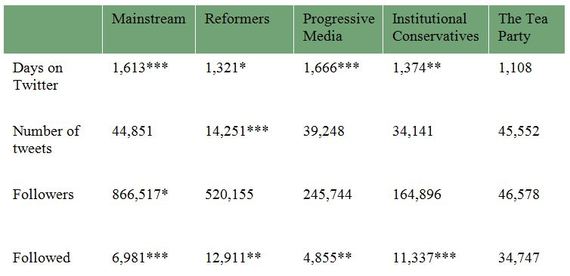




Thank you! We are ready to roll.
05-01-2024, 02:07 PM in illegal immigration Announcements